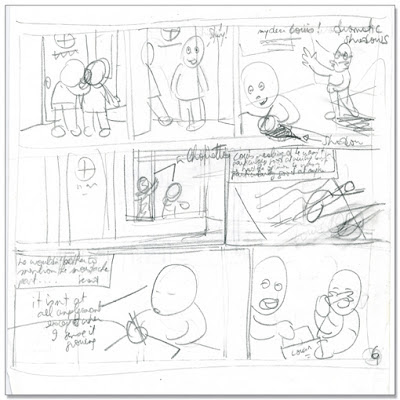5 Tips on Getting Started Creating a Graphic Novel – Part One
Whether you’re thinking of writing and drawing the entire book yourself, or of working with a writer or an artist, it’s a good idea to have an all round knowledge of how comics and graphic novels work.
Naturally, there are no set rules for creating a comic, and every artist or creator will approach things uniquely. There is no right way to begin a graphic novel story and there can of course be an exciting experimentational period of creativity before the exact direction of the story emerges.
In this initial blog post we’ll look at 5 simple tips for writing a comic story.
 |
| Example of a page of script for our graphic novel Louis – Red Letter Day |
2. Making thumbnails. Thumbnails, or layout, are basically a rough draft of your story in words and pictures. At this point the artwork is just made of sketches. This is a crucial stage in the planning, as it is where you can work out how the story is actually reading visually. At this stage you can also try out different versions of thumbnails, to find the best possible way to lay out your story. Sometimes we have made as many as 12 drafts of a thumbnail sequence before getting it right! This obviously saves an enormous amount of work later on: imagine you did 12 pages of final artwork, only to realise that the story doesn’t read well and you’d like to redo it. Final artwork can be extremely time consuming to produce.
 |
| Example of thumbnails, or layout pages, for Louis – Red Letter Day. Extract from the making-of section in the new hardback edition of Louis – Red Letter Day. |
3. Edit, edit, edit. Whether you write a script first or jump straight to thumbnails, don’t be afraid to rework. And then to rework some more. Cut back on word count. A comic story takes a lot more space to tell than a novel, because the art takes so much space. This means that your story can very quickly expand to thousands of pages. Also, there’s not much room in a comic panel to fit text, and, words and pictures work best together when they are balanced. What that balance is depends on your style, but a page heavy in text is likely to put off a reader, or even to lose them all together. So try to keep things succinct. Edit and change the words until they are as good as they can be. Edit and change the layout until you have found the best way to tell your story.
4. The important information goes in the text. Every reader reads a graphic novel novel differently. Some absorb all the information, text and images, carefully. Others skip over the pictures and only read the text. So make sure all your important story elements are in the dialogue and or narrative text, not only in the images, as they may end up being missed all together.
5. Give your brain time to incubate. Leaving a story aside for a few days or more is sometimes necessary. You can come back to it more objectively, take stock of what you have produced and see what needs to be changed much more clearly. Your brain is doing work for you without you knowing about it. Problems can be solved when you stop thinking about them for a while and come back to them afresh.
In our next post, we’ll look at thumbnailing and page layout, so stay tuned.
We’d be interested in hearing how other people approach their own creative process. How do you work and create your own comics? Do you have any tips? You are most welcome to leave your comments below this post!


April 16, 2014 @ 8:27 am
Thanks for writing this. I'm an all-in-one kind of artist; I am doing the writing as well as the artwork, and I typically brainstorm with text, notes, thumbnails, and a little bit of color all on one page. I like to lay out the theme/mood on the page in a way that complements the dialogue. But I love blogs like this. At this gage in the game, I'm about as clueless as anything. Thanks for your tips!
April 16, 2014 @ 11:37 am
Many thanks for your comment and for kindly sharing your working method. All the best with your work!